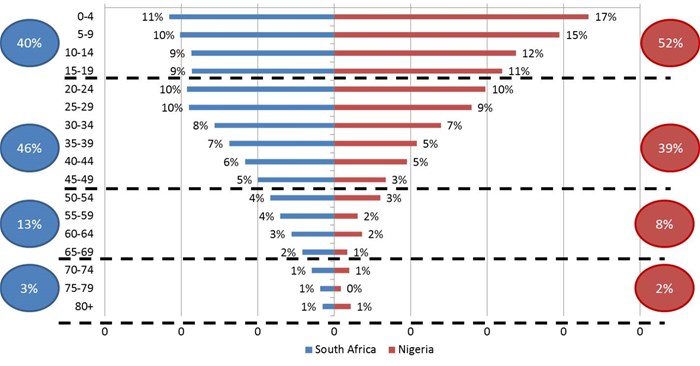Like most people, I find it much easier to learn about new things if I can frame them around something I already know. What easier way to learn about a country that’s new to you, than to frame or compare it to a country you know very well, like South Africa.

Let’s start with size: South Africa is 1.221 million km2 whereas Nigeria is 923 768 km2. So South Africa is a third bigger but hey, that’s still pretty hard to visualise. The map below makes it easier, with Nigeria overlaid on South Africa and clearly South Africa is the larger land size.
Nigeria, has significantly more people with a total estimated population of over 182 million whereas South Africa has an estimated 54.96 million people. Now imagine a square km: in South Africa there would be 45 people standing in that space versus 195, four times more, in Nigeria. That’s pretty crowded!
Nigeria has 36 states, whereas in South Africa we only need to deal with nine provinces.
If you took R1 to Nigeria you would get 12.88 Naira (₦). If you thought R15.22 to the $ was bad try ₦199 to the $.
Both countries rely on commodities to generate critically needed export revenues but Nigeria relies massively on oil revenues while South Africa has a far more diversified economy. In addition, albeit less frequent in South Africa, electrical outages plague businesses in both regions with generators being a necessity to continue trading.
South Africa has incorporated 11 different official languages into its constitution but imagine if Nigeria were to do the same with 512 languages spoken there. There used to be 521 languages spoken in Nigeria but nine are now extinct.
Both countries have invested age pyramids as you can see from the graph below. This is the direct opposite to the aging population of first world countries, which bodes well for the future growth of both countries.

40% of South Africa’s population is younger than 20 and 52% of Nigeria’s population is younger than 20. The challenges of having a significantly large, young population impacts on all levels: economically, the provision of education, employment, medical facilities and so forth.
South Africa is more fortunate as we have at least 46% of our population aged 20-49, in the prime of their lives and hopefully able to pave a solid economic foundation for the youth as they grow up. Only 39% of Nigeria’s population is 20-49. Literacy amongst adults, aged 15+, in South Africa is measured at 94% vs 60% in Nigeria.
Moving onto industry research data, which is common to both regions, being the All Media & Products Survey, we’re able to get a better understanding of the 15+ Adult markets. Nigeria has a slightly more male adult population at 51% vs South Africa at 48%.
In South Africa the top four home languages are Zulu 23%, Xhosa 15%, Afrikaans 14% and English at only 11%. In Nigeria, Hausa ranks top at 28% followed by English at 20%, Yoruba at 19% and Igbo at 12%.
52% of South Africans live in urban areas and 47% live in small urban and rural areas. Nigeria is virtually the opposite, with 54% living in semi-urban and rural areas and 46% living in urban areas.
In South Africa, the four biggest provinces, in terms of concentration of people, are Gauteng with 26% of adults living there, followed by Kwazulu-Natal at 19% and the Eastern and Western Cape both with 12%. In Nigeria, Lagos has 8% of the adult population living there, followed by Kano at 6% and Katsina, Kaduna and Oyo each with 4%.
28% of the adult population in South Africa work full time, 30% are unemployed and 15% are students. Nigeria has a significantly higher proportion of students at 33%, less people working full time at 18% and far less who say they are unemployed, at only 4%.
In South Africa the average household monthly income is R12 013 and in Nigeria its ₦165 016 which equates to R12 828 – not that much different.
The average age of South Africa’s adult population is 38 whereas Nigeria’s adult population is significantly younger – as we saw earlier – at only 30. Surprisingly, even with this younger average age, a higher proportion of Nigerians are married or living together at 45% vs South African’s at only 35%.
In a nutshell, Nigerian’s are younger, have significantly more people living in a smaller space, have a similar household income to South African’s.
Although the official exchange rate in ₦199 to the US$ the unofficial rate, which reflects market realities due to the collapse in the price of oil, is as high as ₦375, so international travel is getting far harder for Nigerians.
Nigeria is more culturally diverse and significantly more economically industrious, with low levels of unemployment.